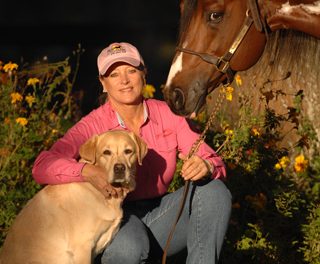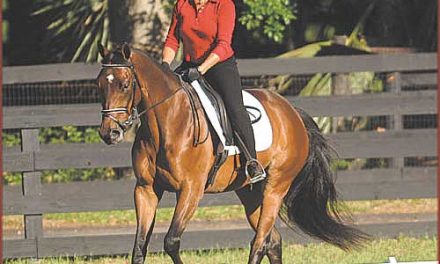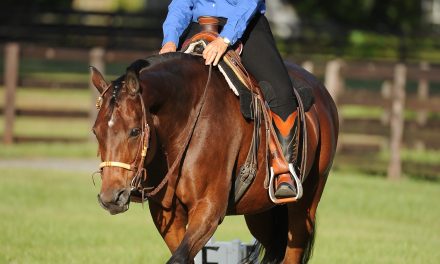Building A Partnership With Your Horse
 In this article, we continue with our series on “training outside the box.” The “box” is the confined area, such as arenas and paddocks, where many riders spend most of their training time.
In this article, we continue with our series on “training outside the box.” The “box” is the confined area, such as arenas and paddocks, where many riders spend most of their training time.
Last month, I gave you some on-the-ground exercises for the rider to do to prepare himself/herself for training outside the box. This next set of exercises is an extension of those done on the ground, but they are done while mounted. Mount your horse and ask him to stand still. Practice these under saddle head to toe stretching and flexibility exercises before each ride.
Head-to-Toe Under Saddle Exercises
Chin Up and Down (Head and Neck Stretch):
Perform this stretch the same way as it was done on the ground. Stay centered in the saddle, sitting square and evenly balanced.
Shoulder Rotations:
This exercise improves the flexibility in the shoulder joint. With the reins in your left hand, place the fingertips of your right hand on top of your right shoulder, keeping your elbow at shoulder height. Slowly rotate your shoulder in a 360-degree arc from front to back and then back to front. Imagine drawing a circle in the air with your elbow! Do several slow circles. Switch arms and repeat.
Punches:
This exercise stretches the hands, elbows, and shoulders. Make a fist with one hand. Punch the hand slowly out in front of you. As you fully extend your arm, open the fingers and stretch out the hand. Repeat punches forward, up overhead, to the side, and down at your side.
Ear Touches:
The purpose of this exercise is to stretch the rider’s back. Keeping your legs in proper riding position, stretch forward from the hips and touch the horse’s ears. If you cannot stretch that far, reach as far forward as possible towards his ears. If you are riding in a Western saddle, stretch forward only with one arm at a time and put the other hand on the horn. If you are riding in an English saddle, stretch both arms forward. Be careful that your legs do not swing back when stretching forward as doing so puts you out of proper position and will prohibit you from getting the full benefit of the stretches.
Tail Touches:
Here is a fun exercise to stretch the upper and lower back and abdominal muscles. Keeping the legs in proper riding position, hold the reins with the right hand and rotate the upper body to the left. As you do so, reach the left hand back toward the top of the horse’s tail. Hold onto the saddle with the hand holding the reins, if needed.
Leg-Over-the-Shoulder Stretch:
It may sound like something a contortionist would do, but this challenging exercise helps develop leg and inner thigh muscles as well as balance. Start with the legs in normal riding position and with feet out of the stirrups. With the knee slightly bent, bring the right leg above the horse’s neck with the foot extended toward the horse’s head. Next, bend the knee and extend the lower leg and foot across the horse’s neck and down toward his left shoulder as you grasp the cantle with your left hand for stability. The leg should be held up and above the horse’s neck and shoulder by several inches. Bring the leg back over the horse’s neck and return it to normal riding position. Do the same exercise with the other leg. The goal of this exercise is to not touch the horse’s neck. If the horse is not used to this type of movement from you or if he reacts, just lift your leg to the middle of his neck and scratch his neck with your toe.
Knee Touches:
With both hands behind you, grasp the cantle, keeping the elbows slightly bent. Bring the upper body back slightly as you lift both knees up at the same time. Touch the knees together over the horse’s withers or the saddle horn and slowly bring them back to the starting position. Slightly rocking the upper body back as you do this exercise makes the hip joint more flexible. Be careful not to kick your horse! This is a challenging exercise that also builds leg and abdominal muscle strength. If you can only bring the knees up part way, it is okay. Keep practicing a little at a time until you can touch them together.
Side Leg Lifts:
This exercise is done the same way as it was done on the ground. It really works the inner thigh muscles and hip area. Take both feet out of the stirrups. Lift and extend one leg out to the side while keeping the other leg down in proper riding position. Do several lifts on each side. You should notice a feeling of sitting deeper in the saddle after completing the side leg lifts.
Upper Thigh and Ankle Flex:
This is a great exercise for stretching the quadriceps—the large front thigh muscles—and for improving ankle flexibility. Take the right foot out of the stirrup and flex the knee and bring the foot up and behind you to the back of the saddle’s cantle. Grasp the back of the ankle with your right hand as you keep the foot flexed. Hold this stretch for five to ten seconds and breathe while doing it. Keep the knee on the saddle and stretch the upper leg down. Release the ankle and allow the lower leg to stretch back down toward the stirrup. Do the same with the other leg.
Toe Points:
With your feet out of the stirrups, flex one ankle so that the toes point upwards. Hold for a few seconds, and then flex the ankle so the toes point towards the ground. Do five toe points with each foot.
You have now learned how to prepare both your horse and yourself for training outside the box. In the next article, I will discuss setting goals for training on the trails. If you would like to work ahead, my E-Book, Training Outside the Box, will give you all the details for how to optimize your enjoyment of training outside the box. You may purchase it and other fine training products at www.lynnpalm.com or by contacting us at 1-800-503-2824.
My E-Book, Training Outside the Box, is available online at www.lynnpalm.com along with my Longevity Training Tape #5, The Art of Longeing, and other valuable training products. Or contact us at 1-800-503-2824




